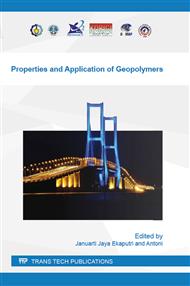p.1
p.7
p.16
p.21
p.26
p.30
p.34
p.40
Effect of Poly(Ethylene-co-Vinyl Acetate) as a Self-Healing Agent in Geopolymer Exposed to Various Curing Temperatures
Abstract:
The elevated temperature curing could cause rapid evaporation of moisture from geopolymer framework, which in turn will trigger a drying shrinkage to the specimen and affect the performance of hardened geopolymer. Different studies have been done on the characteristics of fly ash based geopolymer, yet scarce studies are available on the addition of self-healing agent to reduce shrinkage phenomenon during heat curing. This study experimentally examines the effect of PVA (poly ethylene vinyl acetate) as a self-healing agent on the mechanical properties of geopolymer mortar after 24 hours curing in various temperatures. The effect of PVA was evaluated at 1% of fly ash weight in geopolymer mixture with various curing temperatures of 70, 80, and 90 oC. The curing process of geopolymer mortar was done for 24 hours without any post-cast detainment period. Compressive strength and porosity tests were conducted to provide fundamental information on the hardened properties of geopolymer mortar. Based on the results, 90oC heat curing showed higher improvement on compressive strength properties than other specimens. Strength development of geopolymer mortar was also affected by various geopolymerization rate that relies on the heat exposure.
Info:
Periodical:
Pages:
16-20
Citation:
Online since:
January 2016
Authors:
Keywords:
Price:
Сopyright:
© 2016 Trans Tech Publications Ltd. All Rights Reserved
Share:
Citation:


